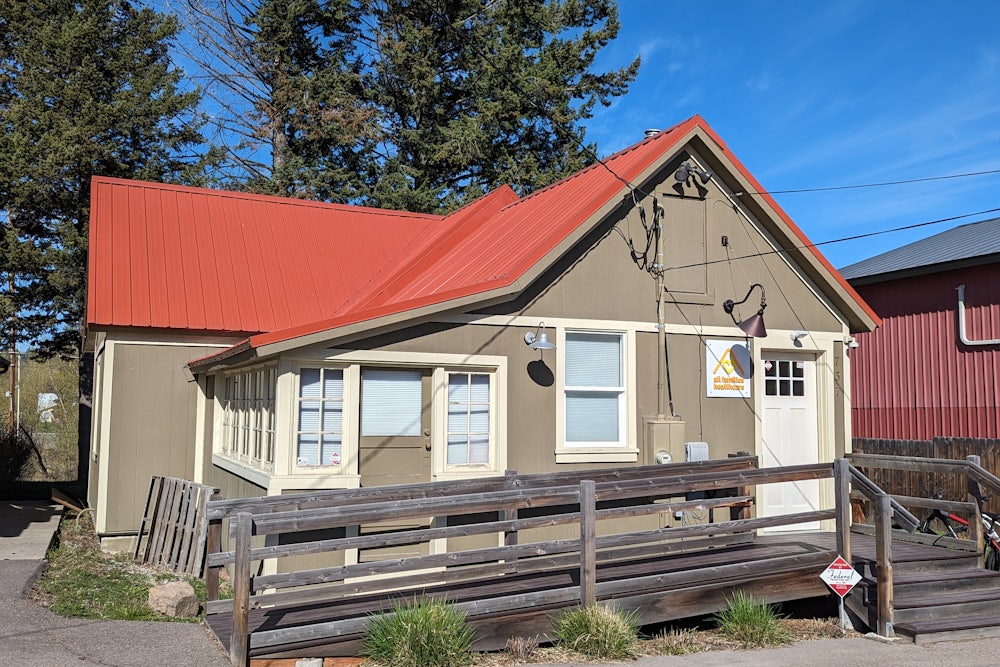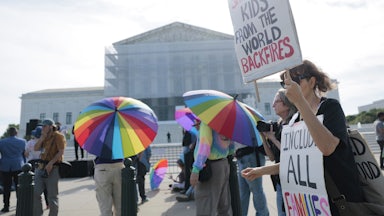Inside the small waiting room of All Families Healthcare in Whitefish, Montana, beside the reception desk, there’s a side door covered from top to bottom in a paper trail of gratitude. There are homemade or store-bought “thank-you” cards. There are long and detailed letters, handwriting cramped to fit limited space. There’s also humor: “Keep your filthy laws off my silky drawers.”
All Families Healthcare is one of only five clinics providing abortion services in the entire state. It is a cozy property that looks more like a house than a medical facility, although the anti-abortion protesters who regularly congregate on the sidewalk outside are an easy giveaway of its function. For owner Helen Weems, the clinic’s mission has become ever more critical in the two years since the Supreme Court overturned Roe v. Wade.

Montana’s abortion laws have remained unchanged since that seismic Dobbs ruling: Despite repeated efforts by the Republican-controlled legislature to limit access, the state Supreme Court has upheld the right to obtain an abortion through fetal viability, around 24 weeks of pregnancy. But Montana is surrounded by states that have restricted or outright banned the procedure since Dobbs, making it a haven for abortion access in the upper Mountain West.
Nonetheless, Montana itself could still be considered hostile territory for abortion providers. Whitefish is a small, Democratic-leaning city in the otherwise red Flathead County in northwest Montana. The original All Families Healthcare clinic in nearby Kalispell was destroyed by arson in the 1990s. It was rebuilt, but owner and founder Susan Cahill closed it down after it was broken into and vandalized in 2014. When Weems, a nurse practitioner, moved to the area in 2016, she asked Cahill to come out of retirement and act as a mentor, so that she could reopen the clinic. Cahill acquiesced, and the new All Families opened in 2018.
“It’s a new clinic, it’s a new site, it’s my business. It’s a new All Families. But it’s a little bit of a ‘phoenix rising’ kind of thing,” Weems told me in an interview in the clinic in April. “The work was too important. The legacy was too important. [Cahill] came back and trained me, and I have proceeded and not once looked back.”
The significance of the facility is evidenced by its isolation: The next-closest abortion clinic is a two-and-a-half-hour drive away in Missoula. (All Families also provides additional health services beyond abortion care.) In its first year, Weems said, All Families provided around 100 abortions; in 2023, it provided nearly 400 abortions, around three-quarters of which were medication abortions. For patients from neighboring states, Weems instructs them to cross the border into Montana and pick up the medication at a local post office.
This is also convenient for patients from more remote parts of Montana—44 percent of the state’s population live in rural areas—who may need to travel to a faraway P.O. box to pick up the mailed medication. Eastern Montana is a desert for abortion access, with some residents a nine-hour drive or more from the closest clinic. Many of Weems’s patients may already have children at home or be working full-time, she said.
“It just becomes totally untenable for them to be able to take that time off to be able to travel for abortion, and so medication abortion by mail has just really revolutionized access,” she continued. In 2021, the Montana state legislature passed laws aiming to severely limit access to this method, by prohibiting the prescription of medication abortions via telehealth services, requiring a 24-hour waiting period for medication abortions, and mandating an ultrasound before providing an abortion. These laws were struck down by the state Supreme Court, upholding a 1999 precedent that the Montana Constitution’s right to privacy allows for access to abortion.
All Families is especially affected by cases currently before the U.S. Supreme Court: one which could limit access to mifepristone, a key medication used for abortions, and one on whether to uphold a total abortion ban in Idaho, a case that could have far-reaching consequences for access to abortion across the country in emergency circumstances. All Families has seen an increase in patients from Montana’s neighbor to the west.
“There’s so much fear among people coming from Idaho, and such gratitude for being able to access services here,” said Weems, adding that she recommends that patients do the procedure inside Montana’s borders “so that they know they’re not pregnant when they go back to Idaho, because it’s scary to be pregnant in Idaho. It’s dangerous to be pregnant in Idaho.”
It may also be considered dangerous to operate an abortion clinic in Montana, particularly when its predecessor was shut down due to external threats twice before. But Weems considers it her responsibility to continue servicing northwestern Montana.
“There’s a moral calculation about what level of risk I’m willing to take to provide what is completely essential health care, and can really change lives,” she said. “And my calculation is that it’s the right path and that I will continue this work, really no matter what.”
The future of access to abortion in Montana may soon be on the ballot. Abortion rights advocates are collecting signatures for an initiative that would amend the state constitution to protect abortion access through fetal viability. Supporters need to collect more than 60,000 signatures by the June 21 deadline. (The state Supreme Court recently ruled that signatures could be gathered without legislative review.)
The initiative may have repercussions for critical elections in Montana. Senator Jon Tester, an endangered Democrat, is up for reelection this year, while Democrat Monica Tranel is hoping to unseat GOP Representative Ryan Zinke in a competitive House race. Support for protecting abortion rights could help turn out voters who might be inclined to support Democrats, such as college students. One bright April morning in Missoula, home to the University of Montana, several students were posted on street corners, asking passersby for signatures to get the initiative on the ballot.
“Freedom is an important issue in Montana. This is a fundamental freedom,” said Tester, adding that the abortion ballot initiative could “possibly” motivate voters who might not otherwise turn out. He was quick to add: “Regardless of whether it’s on the ballot or not, I still win.”
However, Robert Saldin, a political science professor at the University of Montana, expressed skepticism that the initiative would turn out many new voters. He noted that several of the abortion ballot initiatives that have been approved in other red states occurred during off years—for example, in Kansas in August 2022 and in Ohio last year—without a presidential election at the top of the ticket.
“Who’s otherwise not going to be motivated to turn out for a presidential [election] featuring Trump? Who’s going to come out to vote because of the abortion issue, who otherwise wouldn’t have? I’m just skeptical that that’s a large number,” Saldin said.
Still, Tranel told me that she believed the issue could motivate Republicans as well as Democrats. She recalled talking to a conservative voter who nonetheless believed that abortion access was important. “I think this is an issue that will get crossover votes in a way other issues wouldn’t,” Tranel told me.
Zinke said that he believes the “overwhelming majority of Montanans would stand by” the legislature’s efforts to limit the procedure after 20 weeks, even though it had been thwarted by the state Supreme Court. Tranel is “open-ended” on the issue of abortion, Zinke argued, “and Montana’s not there.”
Regardless of the politics of the issue, Weems is hopeful the initiative will make it onto the ballot—and then be approved—because it would provide “clarity” for All Families Healthcare and the state’s other clinics. She has spent several years fighting for the right to provide abortion care: as a plaintiff in a case that overturned legislative efforts to prevent nurse practitioners from providing abortion services in Montana, and more recently in a lawsuit that she joined challenging a law requiring abortion clinics to be licensed by the state.
“It might not slow down the attacks on abortion access, but it would make their defense more robust,” she said. “I would like to think that I wouldn’t have to spend as much time fighting.”






